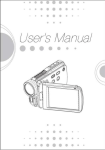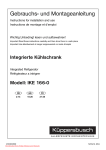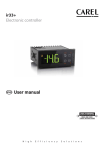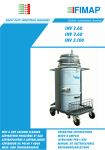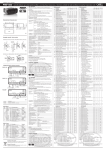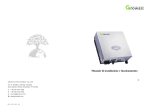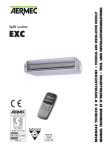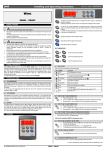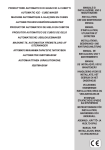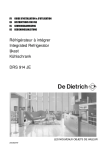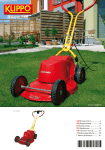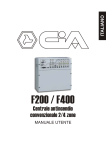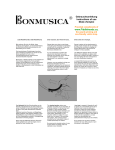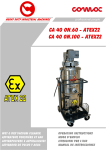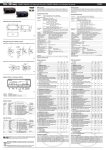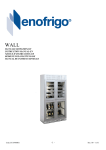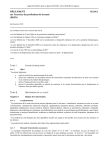Download Ethan Frome
Transcript
LIBRETTO ISTRUZIONI INSTRUCTIONS MANUAL LIVRET D’INSTRUCTIONS GEBRAUCHSANWEISUNG DIRETTIVE CEE 89/392 - 73/23 REV. 1/06.2002 SERIE GASTRO BUFFET “MUSIC” – DROP IN mod. KIT RF TANGO 1400 – 2000 mod. KIT RF MAMBO 1400 – 2000 mod. KIT RF BOLERO 1400 - 2000 mod. KIT RF RUMBA 1400 - 2000 mod. KIT RF 1400 - 2000 1 PAG. INDICE INDEX TABLE DES MATIERES INHALTSVERZEICHNIS AVVERTENZE 2 DATI DI IDENTIFICAZIONE 2 DESCRIZIONE IMPIANTO 4 DESTINAZIONE D' USO 4 TRASPORTO 4 ASSISTENZA 6 INSTALLAZIONE 6 REGOLAZIONE 6 CONSIGLI DI FUNZIONAMENTO 8 SCHEMA ELETTRICO 10-11-12 INSTALLAZIONE E MONTAGGIO DROP IN 13 CONSIDERAZIONI GENERALI 17 ISTRUZIONI PER L’UTILIZZO DEL TERMOSTATO DIGITALE 19 AVVERTENZE IMPORTANT NOTES AVERTISSEMENTS WICHTIGE HINWEISE -PERICOLO GENERICO -GENERAL RISK -DANGER GÉNÉRIQUE -ALLGEMEINE GEFAHRENSTELLE -LEGGERE ATTENTAMENTE IL MANUALE DI ISTRUZIONI -READ THE INSTRUCTIONS MANUAL CAREFULLY -LIRE AVEC ATTENTION LE MANUEL D’INSTRUCTIONS -DAS GEBRAUCHSHANDBUCH AUFMERKSAM LESEN L' impianto e' stato progettato e realizzato in ottemperanza alle Dir. CEE 73/23. Esso risulta quindi sicuro. Inoltre l’impianto è conforme alla direttiva CEE 89/336 sulla compatibilità elettromagnetica. Tuttavia indichiamo i seguenti obblighi per l' utilizzatore: - Non lasciare l' impianto incustodito soprattutto in presenza di bambini. - Non asportare le protezioni della ventola di raffreddamento del condensatore PERICOLO DI TAGLIO. - Evitare di posizionare l' impianto in prossimita' di fonti di calore (caloriferi , forni) o di correnti d' aria. - Evitare l' esposizione ai raggi solari diretti PERICOLO DI CATTIVO FUNZIONAMENTO DELLA REFRIGERAZIONE (CIBO AVARIATO). - L' impianto non e' stato progettato per essere utilizzato all' esterno, e deve essere in ogni caso collegato a MASSA. - Qualsiasi operazione di installazione, manutenzione, pulizia e riparazione deve venire eseguita in assenza di tensione elettrica. - Prima di utilizzare l’apparecchio controllarne l’integrità e leggere il presente manuale. - Non utilizzare l’apparecchio con alimentazione di rete fuori targa. La targhetta di identificazione e' posta sotto il mobile (vedi disegno). I dati riportati sono: - Dati indentificativi del fabbricante - Modello dell' impianto - Numero di serie - Anno di costruzione - Marchio CE di conformita' - Classe climatica del mobile - Dati tecnici Per qualsiasi richiesta di intervento Vi preghiamo di comunicare i dati contenuti nella targhetta di identificazione. DATI DI IDENTIFICAZIONE ID DATA DONNEES D'IDENTIFICATION IDENTIFIZIERUNGSDATEN 2 PAG. IMPORTANT NOTES 3 ID DATA 3 SYSTEM DESCRIPTION 5 PLANNED USE 5 DISPATCH 5 TECHNICAL SUPPORT 7 INSTALLATION 7 SETUP 7 OPERATING ADVICE 9 WIRING DIAGRAM 10-11-12 INSTALLATION AND ASSEMLING DROP IN 13 GENERAL REMARKS 17 INSTRUCTIONS TO USE THE DIGITALE THERMOSTAT 26 PAG. AVERTISSEMENTS 3 DONNEES D'IDENTIFICATION 3 DESCRIPTION DE L'INSTALLATION 5 APPLICATION 5 TRANSPORT 5 SERVICE APRES-VENTE 7 INSTALLATION 7 REGLAGE 7 CONSEILS DE FONCTIONNEMENT 9 SCHEMA ELECTRIQUE 10-11-12 INSTALLATION ET ASSEMBLAGE DROP IN 13 CONSIDERATIONS GENERALES 18 INSTRUCTIONS POUR L’UTILISATION DU THERMOSTAT DIGITALE 26 SEITE WICHTIGE HINWEISE 3 IDENTIFIZIERUNGSDATEN 3 BESCHREIBUNG DER ANLAGE 5 VERWENDUNGSZWECK 5 TRANSPORT 5 KUNDENDIENST 7 INSTALLATION 7 EINSTELLUNG 7 RATSCHLÄGE ZUM BETRIEB 9 ELEKTRISCHES SCHEMA 10-11-12 EINBAU UND MONTAGE VON DROP IN 13 ALLGEMEINE BEMERKUNGEN 18 ANWEISUNGEN FÜR DIE VERWENDUNG DES DIGITAL THERMOSTATS 26 The system has been designed and manufactured in compliance with EU directives 73/23. Therefore it is safe to use. The unit also complies with EU directive 89/336 on electromagnetic compatibility. However, please note the user has to heed the following regulations: - Do not leave the system unattended especially if children are present. - Do not remove the condenser cooling fan guards. CUTTING HAZARD - Do not place the system close to heat sources (radiators, ovens) or draughts. - Do not expose the system to direct sunlight. THIS MAY CAUSE IMPROPER REFRIGERATION OPERATION (ROTTEN FOOD) - The system has not been designed for outdoor use. - Check that the electrical connection includes an earth wire connection and other electrical requisites according to regulations. - Any installation, maintenance, cleaning or repair jobs must be carried out with the power off. - Before using the appliance, check that it is undamaged and read this manual. - Do not use the appliance at a mains voltage higher than on the data plate. L'installation a été projetée et réalisée conformément aux Directives CEE 73/23 et donne donc toutes les garanties de sécurité. L'appareil est conforme en outre à la Directive Cee 89/336 sur la compatibilité électromagnétique. Toutefois, nous énumérons ci-après les obligations suivantes pour l'utilisateur: - Ne pas laisser l'installation sans surveillance, surtout en présence d'enfants. - Ne pas enlever les protections du ventilateur de refroidissement du condenseur. Die Anlage wurde gemäß der Richtlinie 73/23/EWG konzipiert und gebaut und garantiert daher einen sicheren Betrieb. Das Gerät entspricht außerdem den Bestimmungen der Richtlinie 89/336/EWG über die elektromagnetische Verträglichkeit. Trotzdem hat der Verwender einige wichtige Regeln zu befolgen: - Die Anlage nicht unbeaufsichtigt lassen, vor allem wenn Kinder in der Nähe sind. - Die Schutzabdeckungen des Kühllüfters des Kondensators dürfen nicht abgenommen werden. SCHNEIDEGEFAHR. - Die Anlage darf nicht in der Nähe von Wärmequellen (Heizkörper, Öfen) oder Zugluft aufgestellt werden. - Die Anlage darf keinen direkten Sonnenstrahlen ausgesetzt werden. GEFAHR DES SCHLECHTEN KÜHLBETRIEBS (VERDORBENE SPEISEN). - Die Anlage wurde nicht für die Benutzung im Außen konzipiert. Überprüfen Sie, ob die elektrische Spannung nicht nur mir Erdung versehen ist, sondern auch ob die weiteren Bestimmungen und Normen bezüglich der elektrischen Anlagen befolgen sind. - Vor jedem Installations-, Wartungs- , Reinigungs -und Reparatureingriff muß die Stromzufuhr unterbrochen werden. - Vor der Verwendung die Unversehrtheit des Geräts prüfen und dieses Handbuch lesen. - Das Gerät nicht verwenden, falls die Netzspannung auf dem Typenschild mit der örtlicher Netzspannung nicht übereinstimmt. The serial plate is located under the unit (see drawing): The following data is specified: - Manufacturer's identification data - System model - Serial number - Year of manufacture - EU compliance mark - Climatic class - Specifications For any servicing requests, please advise us of the data specified on the serial plate. La plaquette d'identification est située au dessous du meuble (voir dessin). Les données indiquées sont: - Identification du constructeur - Modèle de l'installation - Numéro de série - Année de construction - Label CE de conformité - Classe climatique - Caractéristiques techniques Pour toute demande d'intervention, nous vous prions de communiquer les données contenues dans la plaquette d'identification. RISQUE DE COUPURE. - Eviter de positionner l'installation à proximité de sources de chaleur (radiateurs, fours ou courants d'air). - Eviter l'exposition directe aux rayons solaires. RISQUE DE MAUVAIS FONCTIONNEMENT DE LA REFRIGERATION (ALIMENTS AVARIES) - L'installation n'a pas été projetée pour être utilisée à l'extérieur. - Vérifier que la connexion électrique soit non seulement munie de mise a la terre mais qu’elle correspond aussi aux autres dispositions et réglementations relatives aux installations électriques de l’alimentation. - Toutes les opérations d'installation, d'entretien, de nettoyage et de réparation doivent être exécutées après avoir interrompu l'alimentation électrique. - Avant l’utilisation de l’ appareil, il faut contrôler son integrité et lire ce manuel d’instructions. - Ne pas utiliser l’appareil si la tension indiquée sur la plaque signaletique ne correspond pas au secteur local. 3 Das Typenschild befindet sich unter dem Gerät (siehe Zeichnung). Darauf sind folgende Daten angegeben: - Identifizierungsdaten des Herstellers - Modell der Anlage - Seriennummer - Baujahr - CE-Konformitätszeichen - Klimaklasse - Technische Daten Bei jeder Anforderung von Reparaturbzw. Wartungseingriffen bitten wir Sie um Angabe der auf dem Typenschild aufgeführten Daten. DESCRIZIONE DELL' IMPIANTO SYSTEM DESCRIPTION DESCRIPTION DE L'INSTALLATION BESCHREIBUNG DER ANLAGE 1 2 4 5 3 DESTINAZIONE D' USO PLANNED USE APPLICATION VERWENDUNGSZWECK -PERICOLO GENERICO -GENERAL RISK -DANGER GÉNÉRIQUE -ALLGEMEINE GEFAHRENSTELLE -LEGGERE ATTENTAMENTE IL MANUALE DI ISTRUZIONI -READ THE INSTRUCTIONS MANUAL CAREFULLY -LIRE AVEC ATTENTION LE MANUEL D’INSTRUCTIONS -DAS GEBRAUCHSHANDBUCH AUFMERKSAM LESEN TRASPORTO DISPATCH TRANSPORT TRANSPORT Gli impianti di ristorazione refrigerati sono cosi' strutturati: - Struttura del mobile e della base in lamiera di acciaio - Vasca interna in inox isolata con resine poliuretaniche espanse - Calotta superiore in vetro o in plexiglas manufatta, completa di illuminazione interna.(1-2-3-4) - Apertura manuale della calotta.(1-2-3) - Sovrastruttura fissa in vetro (4) - Refrigerazione di tipo statico con condensatore ventilato con evaporatore in serpentina di rame messa a spirale sulle pareti perimetrali della vasca - Scarico sul fondo vasca per scarico acqua di condensazione - Unita' condensatrice del tipo ermetico e condensazione ad aria con termoregolatore elettronico per il controllo automatico della temperatura - Interruttore sul termoregolatore per lampada di illuminazione.(1-2-3-4) Gli impianti di ristorazione sono stati previsti per l' esposizione e la momentanea conservazione di alimenti destinati all' immediato consumo o vendita nei pubblici esercizi quali: Ristoranti, Alberghi, Trattorie, Pizzerie, Gastronomie e a titolo promozionale nei Supermercati. NESSUN ALTRO USO E' CONSENTITO. La ENOFRIGO S.r.l. e' sollevata da ogni responsabilita' nel caso che le unita' da lei prodotte non venissero utilizzate per gli usi previsti. L' impianto imballato e posto su pallet viene caricato con l' ausilio di un carrello elevatore e collocato all' interno dell' automezzo, o vagone o container, fissato con appositi fermi meccanici e protetto ai lati da materiale antiurto. L'ENOFRIGO non risponde dei danni provocati da operazioni mal eseguite. 1-2 4 The refrigerated catering counters are made up as follows: Counter frame and bottom made of stainless steel Stainless steel internal body insulated with polyurethane foam - Top hood made of manufactured plexiglass with internal lighting.(1-2-3-4) Open / close canopy moving with manual mechanism.(1-2-3) Top hood made of glass (4) - Static refrigeration with ventilated copper spiral evaporator on the outer walls of the body - Drain outlet at the bottom of the body to drain off condensate - Watertight air condenser unit with thermostat for automatic temperature control - Separate switch for the lighting lamp.(12-3-4) Les installations de restauration réfrigérées sont structurées de la façon suivante: - Structure du meuble et de la base en acier - Cuve interne en inox isolée avec résines polyuréthannes expansées - Coupole supérieure en plexiglas galbée, avec éclairage interne.(1-2-3-4) - Actionnement "ouvre et ferme" raccordé à un mécanisme manuel.(1-2-3) - Coupole supérieure en glass (4) - Réfrigération de type statique avec condenseur ventilé avec évaporateur à serpentin en cuivre disposé en spirale sur les parois périmétrales de la cuve - Purge sur le fond de la cuve pour le vidage de l’eau de condensation - Unité de condensation de type hermétique et condensation par air avec thermostat pour le contrôle automatique de la température - Interrupteur séparé pour lampe éclairage. (1-2-3-4) Die Kühlanlage für die Gastronomie sind folgendermaßen aufgebaut: - Möbelstruktur und Unterbau aus Stahl - Innere Wanne aus Inox-stahl, isoliert mit Purharzen - Obere handgefertigte Haube aus Plexiglass komplett mit Innenbeleuchtung. (1-2-3-4) Öffnungsund Schließsystem verbunden mit einem manuellen Mechanismus.(1-2-3) - Obere handgefertigte Haube aus Glass (4) - Statische Kühlung mit belüftetem Kondensator mit Verdampfer aus Kupfer-schlangenrohr, das spiralförmig um die Wände der Wanne läuft - Ablaßhahn am Wannenboden zum Entleeren des Kondenswassers - Hermetische Kondensatoreinheit und Luftkondensation mit Thermostat für die automatische Temperaturkontrolle - Separater Schalter für die Beleuchtung. (1-2-3-4) The refrigerated catering counters are designed for display and temporary cold storage of foods served for immediate eating or on sale to the public in Restaurants, Hotels, Cafeterias, Pizzerias, Buffets and for Supermarket promotion. NO OTHER USE IS AUTHORIZED ENOFRIGO S.r.l does not bear any liability if the unit you purchased is not used for its planned purposes. Les installations de restauration réfrigérées ont été prévues pour l'exposition et la conservation momentanée d'aliments destinés à la consommation immédiate ou à la vente dans les établissements publics tels que: Restaurants, Hôtels, Pizzerias, Traiteurs et à titre promotionnel dans les Supermarchés AUCUNE AUTRE UTILISATION N'EST AUTORISEE ENOFRIGO S.r.l. décline toute responsabilité dans le cas où les appareils de sa production sont destinés à des utilisations différentes par rapport aux celles qui sont prévues dans cet opuscule. Die Kühlanlage für die Gastronomie dienen zur Ausstellung und vorübergehenden Konservierung von Nahrungsmitteln, die für den baldigen Verzehr bzw. Verkauf in Restaurants, Hotels, Gaststätten, Pizzerias, Delikatessengeschäften, sowie während bestimmter Werbeaktionen in Supermärkten, bestimmt sind. ANDERE VERWENDUNGEN SIND NICHT ZULÄSSIG. Falls die von ihr gebauten Geräte nicht für die vorgesehenen Zwecke verwendet werden, ist die Fa. ENOFRIGO S.r.l. von jeder Verantwortung befreit. The packaged and palletized system is loaded with a forklift truck and placed in a truck, railcar or container, secured with special mechanical clamps and protected on the sides by shockproof material. ENOFRIGO is not liable for any damage caused by ill-performed jobs. L'installation emballée et mise sur palette est chargée à l'aide d'un chariot élévateur et placée à l'intérieur du camion, wagon ou container, bloquée avec des dispositifs mécaniques et protégée sur les côtés par des matériaux antichoc. Une fois parvenue à destination, elle doit être déchargée de la même manière, c'est-àdire à l'aide d'un chariot élévateur et posée par terre en prenant toutes les précautions nécessaires. ENOFRIGO ne répond pas des dommages provoqués par des opérations effectuées de manière incorrecte. Die verpackte und auf eine Palette gestellte Anlage wird mit Hilfe eines Hubkarrens geladen, in den Lieferwagen bzw. Güterwagon oder Container gestellt, mit dafür vorgesehenen mechanischen Feststellvorrichtungen blockiert und seitlich mit stoßdämpfendem Material geschützt. Die Fa. ENOFRIGO haftet nicht für Schaden, die durch unsachgemäßes Wirken verursacht wurden. 5 Consigliamo di rivolgerVi direttamente alla nostra azienda o ai nostri rivenditori autorizzati che provvederanno alla migliore e razionale escuzione di qualsiasi lavoro di revisione e riparazione mediante personale specializzato e con attrezzature appositamente studiate per tale esercizio. ASSISTENZA TECHNICAL SUPPORT SERVICE APRES-VENTE KUNDENDIENST Sballare accuratamente l' impianto togliendo il cartone principale. Togliere tutti i materiali protettivi dall’ imballo. Posizionare l’impianto in adeguato sito rispettando le norme tecnico-sanitarie e per quanto riguarda l’alimentazione elettrica rispettando le norme del proprio Paese. Verificare che la tensione e la frequenza elettrica disponibile sia la stessa riportata nella targhetta di identificazione. Verificare prima dell’installazione l’integrità dell’apparecchio. Dopo aver pulito e posizionato l’apparecchio verificare i dati delle sue caratteristiche ed usare una presa idonea. E’ obbligatorio avere a monte un differenziale idoneo (vedere targhetta identificatrice). E’ consigliabile che tale operazione sia svolta da un esperto elettricista. I materiali impiegati per l’imballo devono essere smaltiti secondo le leggi vigenti del Paese di utilizzo. AVVERTENZA: Il cavo e la spina di aliemntazione devono risultare facilmente accessibili dopo l’installazione. Qualora evidenziassero segni di usura devono essere immediatamente sostituite. INSTALLAZIONE INSTALLATION INSTALLATION INSTALLATION Azionando l’interruttore circolare si alimenta l’impianto elettrico del mobile. Per far funzionare il mobile sollevare lo sportellino trasparente dello strumento di controllo e premere il pulsante di accensione. Sullo strumento di controllo è presente anche il pulsante per l’accensione e lo spegnimento delle luci. Il pulsante per le luci è riconoscibile dal segno grafico della lampadina. Il termostato elettronico consente la regolazione della temperatura (Set Point) fra 0°C e +10°C. La temperatura preimpostata è di +2°C. Il funzionamento del termostato elettronico è descritto in dettaglio nel manualetto allegato. Viene effettuato automaticamente uno sbrinamento della durata di 120’ ogni 12 ore. E’ tuttavia necessario, ogni due giorni o anche più spesso, operando in condizioni ambientali particolari, effettuare uno sbrinamento “manuale”. Lo sbrinamento manuale va effettuato svuotando completamente il mobile dalle vaschette dei prodotti alimentari e spegnendo l’interruttore generale fino a completo scioglimento del ghiaccio accumulatosi. L’acqua va quindi evacuata e la vasca asciugata. Le migliori prestazioni dell’impianto si hanno con temperatura ambiente di 25° C e con umidita' relativa U.R. 60% (classe climatica 3 secondo EN 441). Prima dell' uso e del collegamento elettrico pulire t le parti con acqua tiepida e saponi neutri sanificanti asciugare accuratamente. REGOLAZIONE SETUP REGLAGE EINSTELLUNG Termoregolatore Thermoregulator Thermoregulateur Wärmeregler Interruttore generale Main switch Interrupteur general Hauptschalter Non usare in nessun caso polveri abrasive o detersivi che potrebbero danneggiare l' impianto sia internamente che esternamente specialmente nelle parti in vetro o plexiglas. 6 We suggest you directly to contact our company or our authorized dealers who will arrange to have any servicing and repair jobs carried out by skilled personnel using tools specially designed for these operations. Nous vous conseillons de vous adresser directement à notre société ou à nos revendeurs agréés qui viendront effectuer, de la manière la plus fiable et rationnelle, tous les travaux de révision et de réparation avec du personnel spécialisé et des équipements spéciaux étudiés pour ce service. Am besten wenden Sie sich direkt an uns oder an unsere Vertragshändler, die für die einwandfreie Ausführung jeder Überholung bzw. Reparatur durch Fachpersonal und mit Spezialwerkzeug sorgen werden. Carefully unpack the system removing the main cardboard. Take off protective packaging materials from all components of the system and lastly remove the wooden pallet underneath. Position the appliance in a suitable site, respecting the technical and health standards and the regulations in force in your own country concerning electric power supply. Check that the electrical voltage and frequency available are the same as those indicated on the serial plate. Before installation, check that the appliance is undamaged. After having cleaned the appliance and put it into position, insert the cable provided in the embedded socket in the base, check the technical data and use a suitable wall socket. It is necessary to have a suitable differential switch upstream (see data plate ). This operation should be carried out by a skilled electrician. The packing materials used must be disposed of in accordance with the laws in force in your Country. IMPORTANT: The power supply cable and the plug must be easly accessible after the installation. If they should ever show of wear and tear, they must be replaced immediately. Déballer soigneusement l'installation en enlevant le carton principal. Positionner l’appareil dans un endroit adéquat en observant les règles techniques et sanitaires et pour ce qui concerne l’alimentation électrique en respectant les normes en vigueur dans Votre Pays. Vérifier que la tension et la fréquence électrique disponible correspondent aux données figurant sur la plaquette d'identification. Avant l’installation, vérifier l’intégrité de l’appareil. Après avoir nettoyé et mis en place l’appareil, enforcer le cable dont il est equipé dans la prise encastrée sur la base,controler les données des caractéristiques de l’appareil et utiliser une prise edéquate. Il est nécessaire d’avoir un différentiel approprié (voir la plaque d’identification ). Il est conseillable aussi que cette opération soit effectuée par un électricien expérimenté. Les matériaux employés pour l’emballage doivent être mis à la décharge selon les normes en vigueur dans Votre Pays. AVVERTISSEMENT: Le cable et la fiche d’alimentation doivent être accessibles facilement après l’installation. Si l’on remarque des signes d’usure, il faut les remplacer immédiatement. Die Anlage sorgfältig aus dem Hauptkarton auspacken. Die Schutzverpackung aller Komponenten der Anlage entfernen und zuletzt die Holzpalette am Unterbau entfernen. Das Gerät auf einem angemessenen Ort aufstellen, um die technischen und sanitären Vorschriften ebenso wie die Spannungsbestimmungen des Landes zu beachten. Vor Aufstellung die Unversehrtheit des Geräts kontrollieren. Nach der Reinigung und Aufstellung des Geräts, das ausgestattene Kabel auf dem Abgreifpunkt der Grundlage stecken, die Kenndaten des Geräts prüfen und einen passenden Stecker anwenden. Es ist notwendig, ein geeignete Differential zu haben (siehe die Identifizierungsschild). Es wird empfholen, diesen Arbeitsgang durch technisches Fachpersonal auszuführen.Vor der Verwendung sicherstellen, daß die Räder durch die zweckmäßigen Sperrungen blockiert werden. Die Verpackungsteile sind nach diesbezüglich geltenden Vorschriften des Landes zu beseitigen. WICHTIGE HINWEISE: Das Kabel und der Speisungsstecker müssen leicht zugänglich nach der Anlage sein. Falls man Verschleißzeichen bemerkt, ist es notwendig sie auszuwechseln. To turn on the electric system press the round switch (main switch). To turn on the unit lift the plexiglass cover of the control instrument and press the starting button. The control instrument includes the lighting switch. The lighting switch is marked by a lamp draining. The electronic thermostat enables to control the temperature (Set Point) between 0°C and +10°C. The preset temperature is set at +2°C. The function of the electronic thermostat is described in detail in the manual supplied. Defrosting is carried out automatically for the duration of 120 minutes every 12 hours. It is however necessary every two days, or even more often when the unit operates in particular conditions to manually defrost. Manual defrosting is carried out by emptying the food containers and switching off the main switch until all the accumulated ice is melted. The water is then removed and the container dried. The best performance of the until is achieved with the ambient temperature of 25 °C and with the relative humidity of 60% (climatic class 3 according to EN441 standard). Do not, under any circumstances, use abrasive or cleansing powder as they might damage both the inside and outside of the system, especially glass and plexiglass parts. On active l’installation èlectrique du meuble en actionnant l’interrupteur gènèral rond. Soulever le couvercle en plexi de l’instrument de contrôle et appuyer le bouton de l’allumoge frigorifique. L’instrument de contrôle comprend aussi le bouton pour l’èclairage. Le bouton de l’èclairage est marquè par le dessin d’une ampoule. Le thermostat életronique permet le réglage de la température (Set Point) entre 0°C et +10°C. La température préintroduite est +2°C. Le fonctionnement du themostat électronique est décrit en detail dans le livret joint. Un dégivrage de 120’ toutes les 12 heures est réalisé automatiquement. Il est cependant nécessaire d’exécuter – en condition ambiente particuliére – un dégivrage “manuel” tous les deux jours ou même plus souvent. On réalise le dégivrage manuel en vidant entièrement le meuble des récipiént des produits alimentaires et en éteindant l’interrupteur général jusqu’à la fonte complète de la glace accumulée. On doit ensuite évacuer l’eau et essuyer la cuve. Les meilleures performances de l’installation s’obtiennent avec une température ambiente de 25°C et une humidité relative H R de 60% (class climatique 3 selon EN441). Avant l'utilisation et le branchement électrique, nettoyer toutes les parties avec de l'eau tiède et des savons neutres puis essuyer soigneusement. N'utiliser en aucun cas des poudres abrasives ou des détergents qui pourraient endommager l'installation tant à l'intérieur qu'à l'extérieur, en particulier sur les parties en verre ou en plexiglass. Wenn man roten Kreisförmigen Schalter antreibt, Kann man elektrische Anlage vom Möbel speisen. Man muß durchsichtiges Fenster vom Kontrollgerät hochziehen und der Startknopf drücken, unu das Möbel in Bewegung zu setzen. Auf Kontrollgerät stehen auch Startknopf und Ausschaltung der. Beleuchtung und den knopf vom Ventilator für anlauffrei der kalotte. Der elektrische Thermostat erlaubt die Temperaturregelung (Set Point) zwischen 0°C und +10°. Die voreingestellte Temperatur ist +2°C. Die ausführlichen Betriebsanweisungen des elektronischen Thermostats sind auf dem beiliegenden Handbuch beschrieben.. Eine Abtauung von 120‘ Dauer je 12 Stunden wird automatisch ausgeführt, trotzdem ist eine “manuelle“ Abtauung jeden zweiten Tag oder auch öfter – bei Sonderumweltbedingungen – notwendig. Die manuelle Abtauung wird durch komplette Entleerung des Möbels von den Nahrungsmittel-Gefäßen und durch die Abschaltung des Hauptschalters bis zur völlstandigen Eisschmelze ausgeführt. Das Wasser wird dann geraümt und das Becken wird trockengerieben. Die besten Leistungen der Anlage werden bei 25°C Raumtemperatur und relative Feuchtigkeit (rF) von 60% (klimatische Klasse 3 nach EN441) erzielt. Vor Gebrauch und Stromanschluß müssen alle Teile mit Warmwasser und neutralen Seifen gesäubert, und danach gut getrocknet werden. Verwenden Sie unter keinen Umständen Scheuerpulver oder Reinigungsmittel, die die Anlage sowohl innen als auch außen, und insbesondere die Teile aus Glas oder Plexiglas beschädigen könnten. 7 CONSIGLI DI FUNZIONAMENTO OPERATING ADVICE CONSEILS DE FONCTIONNEMENT RATSCHLÄGE ZUM BETRIEB -PERICOLO GENERICO -GENERAL RISK -DANGER GÉNÉRIQUE -ALLGEMEINE GEFAHRENSTELLE -LEGGERE ATTENTAMENTE IL MANUALE DI ISTRUZIONI -READ THE INSTRUCTIONS MANUAL CAREFULLY -LIRE AVEC ATTENTION LE MANUEL D’INSTRUCTIONS -DAS GEBRAUCHSHANDBUCH AUFMERKSAM LESEN 8 Accendere l'illuminazione solamente durante il servizio vero e proprio. In caso di intasamento eccessivo di ghiaccio sulle pareti della vasca, disinserire l’impianto. Attendere quindi che il ghiaccio si sia completamente sciolto, scaricare l'acqua che si sara' formata nella vasca e quindi rimettere in funzione l' impianto. E' importantissimo pulire con una spazzola o aspirapolvere almeno ogni 15 giorni il condensatore. Consigliamo di mettere i prodotti alimentari (per quanto sia possibile) gia' refrigerati. Gli interventi devono essere eseguiti in assenza di alimentazione elettrica. Switch on lighting only when actually serving food. If the body walls are excessively clogged with ice, switch off the system power. Then wait for the ice to melt completely, drain off the water formed in the body, and then restart the system. It is very important to clean the condenser with a brush or vacuum cleaner every fortnight. We suggest, if possible, you to place precooled food products in the refrigerated counter. Maintenance work must be carried out with the power off. Allumer la lumière seulement durant le service proprement dit. En cas de formation excessive de glace sur les parois de la cuve, débrancher l'installation. Attendre que la glace ait complètement fondu, vider l'eau recueillie au fond de la cuve, puis remettre l'installation en marche. Il est très important de nettoyer le condenseur avec une brosse ou un aspirateur au moins tous les 15 jours. Nous conseillons de mettre les aliments (dans la mesure du possible) déjà réfrigérés. Les interventions sur l'installations doivent être faites en l'absence d'alimentation électrique. 9 Nur während der eigentlichen Bedienung die Haube anheben und die Beleuchtung einschalten. Wenn die Wände der Wanne übermäßig vereist sind, die Stromzufuhr zur Anlage unterbrechen. Abwarten, bis das Eis vollkommen geschmolzen ist, dann das Wasser, das sich in der Wanne angesammelt hat, mit dem dafür vorgesehenen Ablaßhahn entleeren, und die Anlage wieder in Betrieb setzen. Mindestens alle 15 Tage mit einer kleinen Bürste oder mit einem Staubsauger gesäubert werden. Es empfiehlt sich (soweit möglich) bereits gekühlte Lebensmittel in die Kühlanlage zu stellen. Reparatur- bzw. Wartungseingriffe dürfen erst durchgeführt werden, nachdem die Stromzufuhr unterbrochen wurde. 10 11 12 13 14 15 CONSIDERAZIONI GENERALI GENERAL REMARKS 16 INCONVENIENTI Se l’unità refrigerata non funziona: PROBLEMS If the refrigerate unit does not work: - verificare corretto allacciamento - verificare se inserita la tensione - verificare la taratura del termostato Se dopo aver eseguito tali verifiche l’inconveniente persiste richiedere l’assistenza di un tecnico specializzato. - check that the appliance is correctly connected - check that the appliance is live - check the thermostat setting If the problem persists after you have checked what we say above, ask for the assistance of a skilled technician. MANUTENZIONE Ogni fine giornata, o turno di lavoro, dopo aver disinserito la fonte di energia attendere che l’impianto si sia raffreddato. Prima dell' uso e del collegamento elettrico pulire tutte le parti con acqua tiepida e saponi neutri sanificanti, poi asciugare accuratamente. Non usare in nessun caso polveri abrasive o detersivi che potrebbero danneggiare l' impianto sia internamente che esternamente specialmente nelle parti in vetro o plexiglas. Verificare sempre che il cavo di alimentazione sia integro ed eventualmente sostituirlo. MAINTENANCE At the end of each day, or of each shift, after having disconnected the power supply wait for the appliance to cool down. Do not, under any circumstances, use abrasive or cleansing powder as they might damage both the inside and outside of the system, especially glass and plexiglass parts. Always check that the power cable is unbroken and change it if necessary. INATTIVITA’ In caso di inattività prolungata dell’apparecchio si deve procedere nel modo seguente: INACTIVITY In the case of prolunged inactivity of the appliance, proceed as follows: - staccare la fonte di energia - pulire accuratamente l’apparecchio con prodotti disinfettanti - proteggere l’apparecchio dall’ossidazione con prodotti neutri - coprire onde evitare il deposito di polvere. - disconnect the power supply - clean the appliance accurately with disinfectants - use neutral products to protect the appliance against oxidation - cover it to stop it gathering dust. DEMOLIZIONE Alla fine della sua vita, l’apparecchio si deve smaltire secondo le leggi vigenti del Paese di utilizzo. DEMOLITION At the end of its working life, the appliance must be disposed of in accordance with the laws in force in the country of use. CARATTERISTICHE TECNICHE TECHNICAL CHARACTERISTICS Tensione: Voltage: 220-240 Volt 1ph+T Potenza Kit Rf 1400: 435 W Kit Rf 2000: 464 W Kit Rf (Tango-Mambo-Bolero-Rumba) 1400: Kit Rf (Tango-Mambo-Bolero-Rumba) 2000: 471 W 522 W 220-240 Volt 1ph+Earth Power Kit Rf 1400: 435 W Kit Rf 2000: 464 W Kit Rf (Tango-Mambo-Bolero-Rumba) 1400: Kit Rf (Tango-Mambo-Bolero-Rumba) 2000: 471 W 522 W Lampada fluorescente Kit Rf (Tango-Mambo-Bolero-Rumba) 1400: L 36W/41-827; tensione 220-240 V Kit Rf (Tango-Bolero-Rumba) 2000: L 58W/41-827; tensione 220-240 V Kit Rf (Mambo) 2000: L 2x30W; tensione 220-240 V GARANZIA Fluorescent lamp Kit Rf (Tango-Mambo-Bolero-Rumba) 1400: L 36W/41-827; Voltage 220-240 V Kit Rf (Tango-Bolero-Rumba) 2000: L 58W/41-827; Voltage 220-240 V Kit Rf (Mambo) 2000: L 2x30W; Voltage 220-240 V GUARANTEE Modalità e durata: un anno tranne materiale elettrico. Foro competente: foro di Padova. . Restano esclusi dalla garanzia le parti elettriche ed elettroniche e quei componenti dei Prodotti che per natura o destinazione sono soggetti a deterioramento o logorio. L’Acquirente decadrà dalla garanzia se utilizzerà i Prodotti in modo non conforme alle istruzioni del Venditore; l’Acquirente decadrà altresì dalla garanzia se provvederà autonomamente, e così senza l’autorizzazione e/o il controllo del Venditore a smontare, modificare tentare di riparare i Prodotti. Terms and duration: one year, except electrical material. Competent court: court of Padua. In the warranty electrical and electronic parts as well as those elements that normally wear out are excluded. The warranty will be not valid any longer if the buyer uses the products in a different way from the seller’s instructions, the warranty will be not valid as wellif the buyer by him self and without the permission and the control of the seller dissambles, modifies and tries to repair the products. La ENOFRIGO srl si riserva di apportare modifiche alla ENOFRIGO srl claims the right to introduce changes in manifacturing process and units equipment without costruzione ed alla dotazione dei mobili senza alcun prior notice. obbligo di preavviso. 17 CONSIDÉRATIONS GÉNÉRALES ALLGEMEINE BEMERKUNGEN INCONVÉNIENTS Si l’unité de réfrigération ne marche pas: UNANNEHMLICHKEITEN Falls die Anlage nicht läuft: - vérifier si la connexion est correcte - vérifier si la tension est branchée - vérifier le calibrage du thermostat Si après avoir effectué ces contrôles l’inconvénient persiste, il faut requérir l’assistence d’un technicien spécialisé. - prüfen Sie den richtigen Anschluss; - prüfen Sie die Anschluss - spannung; - prüfen Sie die Eichung des Thermostats. Falls die Unannehmlichkeit nach dieser Kontrolle andauert, sich an einen technischen Fachpersonal wenden. ENTRETIEN A la fin de chaque journée ou d’un travail par roulement, après avoir coupé la source d’énergie et attendu que l’installation se soit refroidie. Avant l'utilisation et le branchement électrique, nettoyer toutes les parties avec de l'eau tiède et des savons neutres puis essuyer soigneusement. N'utiliser en aucun cas des poudres abrasives ou des détergents qui pourraient endommager l'installation tant à l'intérieur qu'à l'extérieur, en particulier sur les parties en verre ou en plexiglass.Vérifier toujours que le câble de l’alimentation soit intact et éventuellement vous pouvez le remplacer. WARTUNG Bei täglichem Arbeitsende oder Arbeitsschicht die Elektrizitätsquelle ausschalten und die Kühlung der Anlage erwarten. Vor Gebrauch und Stromanschluß müssen alle Teile mit Warmwasser und neutralen Seifen gesäubert, und danach gut getrocknet werden.Verwenden Sie unter keinen Umständen Scheuerpulver oder Reinigungsmittel, die die Anlage sowohl innen als auch außen, und insbesondere die Teile aus Glas oder Plexiglas beschädigen könnten. Die Integrität des Speisekabels immer prüfen, falls es rißig ist, sollte es gewechselt werden. INACTIVITÉ Pedant des périodes d’inactivité prolongée de l’appareil, il faut procéder dans la façon suivante: - débrancher la source d’énergie - nettoyer soigneusement l’appareil en utilisant des produits désinfectants - protéger l’appareil de l’oxydation avec des produits neutres - couvrir l’appareil afin d’éviter le dépôs de poussière. DÉMANTELEMENT A la fin de son activité, on doit mettre à la décharge l’appareil selon les normes en vigueur dans le Pays où il a été utilisé. UNTÄTIGKEIT Bei verlängerter Untätigkeit des Geräts auf folgende Weise vornehmen: - die Energiequelle ausschalten - das Gerät mit Desinfektionsmittel sorgfältig reinigen - das Gerät mit neutralen Produkten vor der Oxydation schützen - das Gerät bedecken, um den Staub zu vermeiden. VERSCHROTTUNG Falls man das Gerät abbrechen will, muß man es zu den vorgesehenen Sammelstellen nach den geltenden Bestimmungen des Landes bringen. TECHNISCHE DATEN CARACTERISTIQUES TECHNIQUES Spannung: Tension: 220-240 Volt 1ph+T 220-240 Volt 1ph+T Puissance: Kit Rf 1400: 435 W Kit Rf 2000: 464 W Kit Rf (Tango-Mambo-Bolero-Rumba) 1400: Kit Rf (Tango-Mambo-Bolero-Rumba) 2000: 471 W 522 W Avec lampe fluorescente (tube) Kit Rf (Tango-Mambo-Bolero-Rumba) 1400: L 36W/41-827; Tension 220-240 V Kit Rf (Tango-Bolero-Rumba) 2000: L 58W/41-827; Tension 220-240 V Kit Rf (Mambo) 2000: L 2x30W; Tension 220-240 V GARANTIE Modalité et durée: une année, sauf le matériau électrique. Tribunal compétent: Tribunal de Padoue. La garantie ne comprend pas les parties èlectriques et èlectroniques aussi bien que les èlèments qui s’abiment normalement. La garantie n’est pas valide si l’acheteur utilise les produits de façon différente par rapport aux instrutions données par le vendeur. La garantie n’est pas valide aussi si l’acheteur deémonte, modifie et répare les produits tout seul et sans l’autorisationet le controle du vendeur. ENOFRIGO srl se réserve le droit d’ apporter toutes modifications utiles sans préavise. Leistung: Kit Rf 1400: 435 W Kit Rf 2000: 464 W Kit Rf (Tango-Mambo-Bolero-Rumba) 1400: Kit Rf (Tango-Mambo-Bolero-Rumba) 2000: 471 W 522 W Mit Leuchstofflampe (rohr) Kit Rf (Tango-Mambo-Bolero-Rumba) 1400: L 36W/41-827; Spannung 220-240 V Kit Rf (Tango-Bolero-Rumba) 2000: L 58W/41-827; Spannung 220-240 V Kit Rf (Mambo) 2000: L 2x30W; Spannung 220-240 V GARANTIE Bedingungen und Dauer: ein Jahr außer dem elektrischen Material. Züstandiges Gericht: Gericht von Padua. Von der Garantie sind die elektrischen und elektronischen Teile und jene Elemente ausgeschlossen, die sich normalerweise abnutzen. Die Garantie wird nicht mehr gultig, wenn der Kaufer die Produkte nicht gemass der Anweisungen des Verkaufers verwendet. Die Garantie wird ebensoviel ungultig, wenn der Kaufer selbst, d.h. ohne die Ermachtigung und/oder die Uberprufung des Verkaufers, die Produkte abmontiert, andert und repariert. ENOFRIGO srl behältet sich mögliche Änderungen an Bauweise und Ausstattung der Modellen ohne vorherige Mitteilung vor. 18 WING XW230L 1.Avvertenze generali 1.1 Da leggere prima di procedere ulteriormente nell’utilizzo del manuale. • Il presente manuale costituisce parte integrante del prodotto e deve essere conservato presso l’apparecchio per una facile e rapida consultazione. • Il regolatore non deve essere usato con funzioni diverse da quelle di seguito descritte, in particolare non può essere usato come dispositivo di sicurezza. • Prima di procedere verificare i limiti di applicazione. 1.2 Precauzioni di sicurezza • Prima di connettere lo strumento verificare che la tensione di alimentazione sia quella richiesta. • Non esporre l’unità all’acqua o all’umidità: impiegare il regolatore solo nei limiti di funzionamento previsti evitando cambi repentini di temperatura uniti ad alta umidità atmosferica per evitare il formarsi di condensa. • Attenzione: prima di iniziare qualsiasi manutenzione disinserire i collegamenti elettrici dello strumento. • Lo strumento non deve mai essere aperto. • In caso di malfunzionamento o guasto, rispedire lo strumento al rivenditore o alla “DIXELL s.r.l.” (vedi indirizzo) con una precisa descrizione del guasto. • Tenere conto della corrente massima applicabile a ciascun relè (vedi Dati Tecnici). • Piazzare la sonda in modo che non sia raggiungibile dall’utilizzatore finale. • Fare in modo che i cavi delle sonde, della alimentazione del regolatore della alimentazione dei carichi rimangano separati e sufficientemente distanti fra di loro, senza incrociarsi e senza formare spirali. • Nel caso di applicazioni in ambienti industriali particolarmente critici, può essere utile inoltre adottare filtri di rete (ns. mod. FT1) in parallelo ai carichi induttivi. 2.Descrizione generale L’XW230L è un controllore a microprocessore, formato 38x185, adatto per applicazioni su unità refrigeranti a temperatura normale. Dispone di quattro uscite a relè per il controllo del compressore, luce, allarme e uscita ausiliaria. E’ dotato di due ingressi sonda NTC, uno per la termostatazione, l’altro facoltativo per la visualizzazione a display. Sono presenti inoltre due ingressi digitali (contatti puliti), uno per il microporta e l’altro configurabile da parametro. L’uscita TTL permette il collegamento attraverso un modulo esterno a sistemi di monitoraggio ModBUS-RTU compatibili e la programmazione della lista parametri completa tramite la chiavetta di programmazione “Hot Key”. E’ disponibile l’uscita opzionale per il visualizzatore remoto XW-REP . 3.regolazione 3.1Compressore L’isteresi Hy è automaticamente sommata al set point. Se la temperatura aumenta e raggiunge il set point più l’isteresi, il compressore viene attivato, per essere poi spento quando la temperatura si riporta al valore del set point. In caso di guasto alla sonda l’attivazione e lo spegnimento dell’uscita viene gestito a tempo attraverso i parametri “COn” e “COF”. 3.2Il congelamento Viene attivato, se non è in corso lo sbrinamento, da tastiera tramite il tasto ▲ tenuto premuto per circa 3 secondi. Il compressore funziona in continuo per il tempo. Si può disattivare il ciclo prima dello scadere del tempo ripremendo per 3s il tasto ▲. 3.3Lo sbrinamento Lo sbrinamento è realizzato per fermata semplice del compressore. Attraverso il parametro “IdF” si può gestire l’intervallo tra cicli di sbrinamento, mentre la durata è gestita dal parametro “MdF”. 19 3.4Attivazione uscita ausiliaria L’uscita ausiliaria viene attivata manualmente da tasto posto sul frontale o dall’ingresso digitale opportunamente configurato. 4.frontale Per visualizzare o modificare il set point. In programmazione seleziona un parametro o conferma un valore. Se premuto per 3 sec durante la visualizzazione della MAX o della min temperatura le resetta. Per vedere la massima temperatura raggiunta. In programmazione scorre i codici dei parametri o ne incrementa il valore. Se premuto per 3sec. avvia il ciclo di congelamento. Per vedere la minima temperatura raggiunta. In programmazione scorre i codici dei parametri o ne decrementa il valore. Tenendolo premuto per 3s avvia il ciclo di sbrinamento manuale. Accende e spegne le luci della cella Attiva e disattiva la funzione di Energy Saving Attiva e disattiva l’uscita ausiliaria. Accende e spegne lo strumento. COMBINAZIONI DI TASTI + + + Premuti per 3 sec. bloccano e sbloccano la tastiera Per entrare in programmazione Per uscire dalla programmazione. 4.1SIGNIFICATO DEI LED Sul display esiste una serie di punti luminosi il cui significato è descritto dalla tabella sottostante: LE D MODALI Funzione TÀ ACCESO Compressore attivo LAMPEG Fase di programmazione (lampeggia insieme GIANTE a LED ) - Ritardo antipendolazione ACCESO Sbrinamento attivo ACCESO Congelamento attivo ACCESO Segnalazione ALLARME - In programmazione “Pr2” indica che il parametro è presente anche in “Pr1” In corrispondenza dei tasti sono presenti alcuni leds il cui significato è descritto dalla tabella sottostante: 20 TASTO MODALI TÀ SET LAMPEG GIANTE SET LAMP. VELOCE SBRINAM ACCESO ENTO ENERGY ACCESO SAVING LUCE ACCESO AUX ACCESO ON/OFF ACCESO Funzione E’ visualizzato il set point ed è modificabile Il ciclo di Energy Saving è attivo E’ stato attivato uno sbrinamento manuale Il ciclo di Energy Saving è attivo La luce è accesa L’uscita ausiliaria è attiva Lo strumento è spento. 4.2PER VEDERE LA TEMPERATURA MINIMA 1. 2. 3. Premere e rilasciare il tasto ▼. Verrà visualizzato il messaggio “Lo” seguito dalla minima temperatura raggiunta. Premendo il tasto ▼ o aspettare 5 secondi per visualizzare la temperatura normale. 4.3PER VEDERE LA TEMPERATURA MASSIMA 1. 2. 3. Premere e rilasciare il tasto ▲. Verrà visualizzato il messaggio “Hi” seguito dalla massima temperatura raggiunta. Premendo il tasto ▲ o aspettando 5 secondi si tornerà a visualizzare la temperatura normale. 4.4PER cancellare lE temperature memorizzate 1. Per cancellare le temperature memorizzate, visualizzare la massima o la minima temperatura con i tasti ▲ e ▼ . 2. Premere il tasto SET finché il messaggio “rST lampeggia 3 volte N.B. Resettare le temperature dopo l’installazione dello strumento 4.5PER VEDERE E MODIFICARE IL SET POINT 1. Premere e rilasciare il tasto SET: il set point verrà immediatamente visualizzato. 2. ll led SET lampeggia; 3. Per modificare il valore agire sui tasti ▲ e ▼. 4. Per memorizzare il nuovo set point, premere il tasto SET o attendere 15s per uscire dalla programmazione. 4.6Per avviare un ciclo di sbrinamento manuale 1. Premere il tasto DEF per più di 2 secondi 4.7per accedere ai parametri in “pr1” Per entrare nel menu parametri “Pr1” accessibili dall’utente: 1. Premere per alcuni secondi i tasti SET+ ▼. (I e iniziano a lampeggiare) 2. Lo strumento visualizza il primo parametro presente in “Pr1” 21 4.8per cambiare il valore di un parametro Per cambiare il valore di un parametro: 1) Accedere al modo programmazione, 2) Selezionare il parametro desiderato. 3) Premere il tasto SET per visualizzarne il valore 4) Modificarlo con i tasti ▲ e ▼ . 5) Premere “SET” per memorizzare il nuovo valore e passare al codice del parametro successivo. Uscita: Premere SET+ ▲, quando si visualizza un parametro, o attendere 15s senza premere alcun tasto. NOTA: il nuovo valore impostato viene memorizzato anche quando si esce senza aver premuto il tasto SET. 4.9PER BLOCCARE LA TASTIERA 1. 2. Tenere premuti i tasti ▲ e ▼ per alcuni secondi, finché non appare la scritta “POF” lampeggiante. A questo punto la tastiera è bloccata: è permessa solo la visualizzazione del set point, della temperatura massima e minima, PER SBLOCCARE LA TASTIERA Tenere premuti i tasti ▲ e ▼ per alcuni secondi, finché non appare la scritta “POn” lampeggiante. 4.10La funzione ON/OFF Premendo il tasto ON/OFF lo strumento visualizza “OFF” per 5sec e il led di ON/OFF si accende. In questa configurazione i carichi e tutte le regolazioni sono disabilitate. Per riportare lo strumento in ON premere nuovamente il tasto. La condizione di OFF permette di escludere lo strumento dal monitoraggio senza generare nessun tipo di allarme. N.B. In OFF il tasto LUCE e AUX sono attivi. 5.Lista dei parametri REGOLAZIONE Hy Isteresi: (0,1÷25,5°C; 1÷45°F) Differenziale di intervento del set point, sempre positivo. Il compressore si attiva quando la temperatura aumenta fino a raggiungere il set point + Hy, per poi spegnersi quando viene riportata al valore del set point. LS Set point minimo: (-50,0°C÷SET; -58°F÷SET) Fissa il valore minimo impostabile per il set point. AC Ritardo partenze ravvicinate: (0÷30min) intervallo minimo tra lo spegnimento del compressore e la successiva riaccensione. VISUALIZZAZIONE rES Risoluzione (per °C): (in = 1°C; de= 0,1°C) permette la visualizzazione col punto decimale. SBRINAMENTO IdF Intervallo fra i cicli di sbrinamento: (1÷120 ore) Determina l’intervallo tra l’inizio di due cicli di sbrinamento. MdFDurata (MAX) sbrinamento: (0÷255min) stabilisce la durata dello sbrinamento. ALLARME ALUAllarme MASSIMA temperatura: (se ALC = rE: 0÷50°C ;0÷90°F. Se ALC = Ab: ALL÷110°C; ALL÷230°F) al raggiungimento di tale temperatura viene attivato l’allarme, eventualmente dopo il tempo di ritardo ALd. ALL Allarme minima temperatura: (se ALC = rE: 0÷50°C ;0÷90°F. Se ALC = Ab: ALU÷-50°C; ALU÷-58°F) al raggiungimento di tale temperatura viene attivato l’allarme, eventualmente dopo il tempo di ritardo ALd. INGRESSI ANALOGICI Ot Calibrazione sonda termostato: (-12÷12°C; -21÷21°F) permette di tarare la sonda termostato. ALTRO Adr Indirizzo seriale RS485: (1÷247) Identifica lo strumento quando viene inserito in un sistema di controllo o monitoraggio come l’XJ500. 22 6.Installazione e montaggio Gli strumenti XW230L vanno montati a pannello verticale, su foro 150x31mm, e fissati con 2 viti ∅ 3 x 2mm con distanza 165mm. Per ottenere una protezione frontale IP65 utilizzare la gomma di protezione frontale mod. RG-L (opzionale).Il campo di temperatura ammesso per un corretto funzionamento è compreso tra 0 e 60°C. Evitare i luoghi soggetti a forti vibrazioni, gas corrosivi, a eccessiva sporcizia o umidità. Le stesse indicazioni valgono anche per le sonde. Lasciare areata la zona in prossimità delle feritoie di raffreddamento. 6.1DIMA DI FORATURA +1 -1 150 +0.5 -0 31 +0.5 -0 165 Ø3 x2 6.2montaggio vetrino e calotte frontali con apertura verso il basso 2 CLICK! 1 3 1 2 1 3 6.3montaggio vetrino e calotte frontali con apertura verso l’alto 1 2 3 1 2 3 2 CLICK! 1 7.Collegamenti elettrici Lo strumento è dotato nella parte dedicata agli ingressi analogici e digitali di una morsettiera a vite per il collegamento di cavi con sezione massima di 2,5 mm2 . Nella parte di potenza dove c’è l’alimentazione e tutti i relay le connessioni sono a Faston maschi da 6,3mm. Utilizzare conduttori resistenti al calore. Prima di connettere i cavi assicurarsi che la tensione di alimentazione sia conforme a quello dello strumento. Separare i cavi di collegamento delle sonde da quelli di alimentazione, dalle uscite e dai collegamenti di potenza. Non superare la corrente massima consentita su ciascun relè, vedi dati tecnici, in caso di carichi superiori usare un teleruttore di adeguata potenza. N.B. La corrente totale massima sui carichi non deve superare i 20A. 23 7.1Sonde Si consiglia di posizionare la sonda termostato in luoghi non direttamente investiti da flussi d’aria in modo da poter rilevare la temperatura media della cella. 8.segnalazione ALLARMI Mes Causa s. “P1 Sonda termostato guasta ” Uscite Uscita secondo parametri “Con” e “COF” Non modificate “P3 Sonda ausiliaria guasta ” “HA Allarme di alta temperatura Non modificate ” “LA Allarme di bassa temperatura Non modificate ” “EE Anomalia nella memoria ” “dA Allarme porta aperta Non modificate ” “EA Allarme da ingresso digitale Non modificate L” “BA Allarme di blocco da ingresso Uscite di regolazione L” digitale disattivate “PA Allarme pressostato da Uscite di regolazione L” ingresso digitale disattivate La segnalazione a display permane finché la condizione di allarme non è rientrata. Tutti i messaggi di allarme lampeggiando alternandosi alla temperatura della sonda eccetto “P1” che è sempre lampeggiante. L’allarme “EE” può essere cancellato con la pressione di un tasto qualsiasi durante la segnalazione di allarme. Successivamente viene visualizzato il messaggio “rSt” per circa 3s prima di riprendere il funzionamento normale. 8.1Tacitazione buzzer e uscita allarme Una volta rilevata la segnalazione di allarme il buzzer e l’uscita allarme si possono disattivare con la pressione di un tasto qualsiasi. Comunque la segnalazione a display permane finché la condizione di allarme non è rientrata. É possibile inibire la disattivazione del relay di allarme, impostando il parametro “tbA” a “n” in questo caso il relè allarme rimane attivo finché dura la condizione di allarme. 8.2L’allarme “EE”. Gli strumenti della serie Dixell sono dotati di un controllo interno che verifica l’integrità dei dati. L’allarme “EE” lampeggiante in alternanza alla temperatura segnala la presenza di un’anomalia nei dati. 8.3Modalità di rientro degli allarmi Gli allarmi sonda "P1" e “P3" scattano dopo circa 10 secondi dal guasto della sonda; rientra automaticamente 10 secondi dopo che la sonda riprende a funzionare regolarmente. Prima di sostituire la sonda si consiglia di verificarne le connessioni. Gli allarmi di temperatura "HA" e "LA" rientrano automaticamente non appena la temperatura del termostato rientra nella normalità, alla partenza di uno sbrinamento o all’apertura della porta. L’ allarme di porta aperta ”dA" rientra automaticamente alla chiusura della porta. L’ allarme di ingresso digitale ”EAL" e “BAL” rientrano automaticamente alla disattivazione dell’ingresso. Se l’I.D. è configurato come pressostato “PAL” il ripristino è manuale spegnendo lo strumento. o 9.Dati tecnici Contenitore: ABS autoestinguente. Formato: frontale 38x185 mm; profondità 76mm; Montaggio: a pannello su foro di dimensioni 150x31 mm. con viti ∅ 3 x 2mm distanza tra i fori 165mm. Grado protezione: IP20. Grado protezione frontale: IP65 (con guarnizione frontale mod. RG-L). Connessioni: morsettiera a vite per conduttori ≤2,5 mm2 resistenti al calore per parte a bassissima tensione Faston maschi 6,3mm resistenti al calore per parte a bassa tensione (110 0 230Vac) Alimentazione: 230Vac opp. 110Vac ± 10%, 50/60Hz Potenza assorbita: 7VA max Visualizzazione: tre cifre, LED rossi, altezza 14,2 mm. Ingressi: 2 sonde NTC. Ingressi digitali : microporta e configurabile contatti liberi da tensione Uscite su relè: corrente complessiva sui carichi MAX 20A 24 compressore: relè SPST 20(8) A, 250Vac luce: relè SPST 16(3) A, 250Vac allarme : SPST relè 8(3) A, 250Vac ausiliario: SPST relè 16(3) A, 250Vac Mantenimento dati: su memoria non volatile (EEPROM). Tipo di azione: 1B. Situazione di polluzione: normale. Classe software: A Temperatura di impiego: 0÷60 °C. Temperatura di immagazzinamento: -25÷60 °C. Umidità relativa: 20÷85% (senza condensa) Campo di misura e regolazione: Sonda NTC: -40÷110°C (-58÷230°F) Risoluzione: 0,1 °C oppure 1 °F. Precisione a 25°C:: ±0,5 °C ±1 digit 10.Schemi di collegamento 10.1XW230L Luce RL2 Comp RL1 11.valori standard La Nome bel REGOLAZIONE Set Set point Hy Isteresi Limiti LS÷US 0,1÷25,5 °C / 1÷45°F 0÷30 min. 0÷255 min. Def Livel ault lo °C/° XW F 230L 2 Pr1 1 Pr1 5 AC Ritardo partenze ravvicinate Pr1 30 CO Tempo compressore OFF con Pr2 F sonda guasta VISUALIZZAZIONE De Pr1 rE Risoluzione (per °C) : intero , in ÷ de S decimale SBRINAMENTO 12 Pr1 IdF Intervallo fra i cicli di 1÷120ore sbrinamento 120 Pr1 Md Durata (massima) 0÷255 min. F sbrinamento AL Allarme di massima -50,0÷110°C/ - 13 Pr1 U temperatura 58÷230°F 3 AL Allarme minima temperatura -50,0÷110°C/ Pr1 L 58÷230°F INGRESSI ANALOGICI Ot Calibrazione sonda -12,0÷12,0°C / - 0 Pr1 termostato 21÷21°F INGRESSI DIGITALI ALTRO Ad Indirizzo seriale r 1÷247 1 Pr1 25 17 18 19 21 22 23 Cella 11 12 13 14 XW230L Display 9 10 AUX ALLARME RL6 RL5 MAX 20A Comune Ing. Digitale Microporta 1 2 3 4 16A 20A 250Vac 250Vac Neutro Linea 16A 8A 250Vac 250Vac WING XW230L 12.GENERAL WARNING 12.1 • • • 12.2 • • • • • • • • • Please read before using this manual This manual is part of the product and should be kept near the instrument for easy and quick reference. The instrument shall not be used for purposes different from those described hereunder. It cannot be used as a safety device. Check the application limits before proceeding. Safety Precautions Check the supply voltage is correct before connecting the instrument. Do not expose to water or moisture: use the controller only within the operating limits avoiding sudden temperature changes with high atmospheric humidity to prevent formation of condensation Warning: disconnect all electrical connections before any kind of maintenance. Fit the probe where it is not accessible by the End User. The instrument must not be opened. In case of failure or faulty operation send the instrument back to the distributor or to “Dixell s.r.l.” (see address) with a detailed description of the fault. Consider the maximum current which can be applied to each relay (see Technical Data). Ensure that the wires for probes, loads and the power supply are separated and far enough from each other, without crossing or intertwining. In case of applications in industrial environments, the use of mains filters (our mod. FT1) in parallel with inductive loads could be useful. 13.General description Model XW230L, 38x185 mm format, is microprocessor based controller suitable for applications on medium or low temperature refrigerating units. It is provided with four relay outputs to control compressor, the lights, the alarm and an auxiliary output. It is also provided with two NTC probe inputs, one for temperature control, one optional, for the display. There are two digital inputs (free contact) for the door switch and configurable by parameter. The standard TTL output allows the user to connect, by means of a TTL/RS485 external module, a ModBUS-RTU compatible monitoring system and to programme the parameter list with the “Hot Key”. An optional output for remote display “XW-REP” is available. 14.Controlling loads 14.1The compressor The regulation is performed according to the temperature measured by the thermostat probe with a positive differential from the set point: if the temperature increases and reaches set point plus differential the compressor is started and then turned off when the temperature reaches the set point value again. In case of fault in the thermostat probe the start and stop of the compressor are timed through parameters “COn” and “COF”. 14.2Fast freezing When defrost is not in progress, it can be activated the keypad by holding the ▲ key pressed for about 3 seconds. The compressor operates in continuous mode for the time set through. The cycle can be terminated before the end of the set time using the same activation key, ▲ for about 3 seconds. 14.3Defrost Defrost is performed through a simple stop of the compressor. Parameter “IdF” controls the interval between defrost cycles, while its length is controlled by parameter “MdF”. 14.4auxiliary output The auxiliary output is switch ON and OFF by means of the corresponding button on the keyboard. 26 15.keyboard To display and modify target set point; in programming mode it selects a parameter or confirm an operation. By holding it pressed for 3s when max or min temperature is displayed it will be erased. To see the max. stored temperature; in programming mode it browses the parameter codes or increases the displayed value. By holding it pressed for 3s the fast freezing cycle is started. To see the min stored temperature; in programming mode it browses the parameter codes or decreases the displayed value. By holding it pressed for 3s the defrost is started. Switch ON and OFF the cold room light. By holding it pressed for 3s Energy Saving function is started or stopped. Switch ON and OFF the auxiliary output. Switch ON and OFF the instrument. KEY COMBINATIONS + + + To lock and unlock the keyboard. To enter the programming mode. To exit the programming mode. 15.1Use of LEDS Each LED function is described in the following table. LE MODE Function D ON The compressor is running FLASHIN - Programming Phase (flashing with LED ) G - Anti-short cycle delay enabled FLASHIN Programming Phase (flashing with LED ) G ON The defrost is enabled FLASHIN Drip time in progress G ON The Fast Freezing cycle is enabled ON - ALARM signal - In “Pr2” indicates that the parameter is also present in “Pr1” Function of the LEDs placed on the left top side of buttons: BUTTON MODE FUNCTION 27 SET FLASHIN G SET FAST FLASHIN G DEFROST ON ENERGY ON SAVING LIGHT ON AUX ON ON/OFF ON The Set point is displayed and it can be modified The Energy Saving is enabled The Manual Defrost is activated The Energy Saving is enabled The Light is ON The Auxiliary output is ON (XW270L) The instrument is OFF 15.2HOW TO SEE THE MIN TEMPERATURE 1. 2. 3. Press and release the ▼ key. The “Lo” message will be displayed followed by the minimum temperature recorded. By pressing the ▼ key or waiting for 5s the normal display will be restored. 15.3HOW TO SEE THE MAX TEMPERATURE 1. 2. 3. Press and release the ▲ key. The “Hi” message will be displayed followed by the maximum temperature recorded. By pressing the ▲ key or waiting for 5s the normal display will be restored. 15.4HOW TO RESET THE max and min TEMPERATURE RECORDED To reset the stored temperature, when max or min temperature is displayed : 1. Press SET key until “rST” label starts blinking. N.B. After the installation RESET the temperature stored . 15.5HOW TO SEE and modify the SET POINT 1. Push and immediately release the SET key: the display will show the Set point value; 2. The SET LED start blinking; 3. To change the Set value push the ▲ or ▼ arrows within 10s. 4. To memorise the new set point value push the SET key again or wait 10s. 15.6To start a manual defrost 1. Push the DEF key for more than 2 seconds and a manual defrost will start. 15.7to enter in parameters list “Pr1” To enter the parameter list “Pr1” (user accessible parameters) operate as follows: 1. Enter the Programming mode by pressing the Set and DOWN key for few seconds ( and start blinking). 2. The instrument will show the first parameter present in “Pr1” 15.8HOW TO CHANGE THE parameter value 1. Enter the Programming mode. 2. Select the required parameter with ▲ or ▼. 3. Press the “SET” key to display its value ( and LED starts blinking). 4. Use ▲ or ▼ to change its value. 5. Press “SET” to store the new value and move to the following parameter. 28 To exit: Press SET + UP or wait 15s without pressing a key. NOTE: the new programming is stored even when the procedure is exited by waiting the time-out. 15.9HOW TO LOCK THE KEYBOARD 1. 2. Keep the ▲ and ▼ keys pressed together for more than 3 s the ▲ and ▼ keys. The “POF” message will be displayed and the keyboard is locked. At this point it is only possible the viewing of the set point or the MAX o Min temperature stored and to switch ON and OFF the light, the auxiliary output and the instrument. TO UNLOCK THE KEYBOARD Keep the ▲ and ▼ keys pressed together for more than 3s. 15.10ON/OFF function By pushing the ON/OFF key, the instrument shows “OFF” for 5 sec. and the ON/OFF LED is switched ON. During the OFF status, all the relays are switched OFF and the regulations are stopped; if a monitoring system is connected, it does not record the instrument data and alarms. N.B. During the OFF status the Light and AUX buttons are active. 16.PARAMETER List REGULATION Hy Differential: (0,1÷25,5°C; 1÷45°F): Intervention differential for set point, always positive. Compressor Cut IN is Set Point Plus Differential (Hy). Compressor Cut OUT is when the temperature reaches the set point. AC Anti-short cycle delay: (0÷30 min) interval between the compressor stop and the following restart. DISPLAY rES Resolution (for °C): (in = 1°C; de = 0,1°C) allows decimal point display. de = 0,1°C in = 1 °C DEFROST IdF Interval between defrosts: (1÷120h) Determines the time interval between the beginning of two defrost cycles. MdF (Maximum) duration of defrost: (0÷255 min) it sets the length for defrost ALARMS ALU High temperature alarm setting: ALC= rE, 0 ÷ 50°C or 90°F ALC= Ab, ALL ÷ 110°C or 230°F when this temperature is reached and after the ALd delay time the HA alarm is enabled. ALL Low temperature alarm setting: ALC = rE , 0 ÷ 50 °C or 90°F ALC = Ab , - 50°C or -58°F ÷ ALU when this temperature is reached and after the ALd delay time, the LA alarm is enabled,. PROBE INPUTS Ot Thermostat probe calibration: (-12.0÷12.0°C/ -21÷21°F) allows to adjust possible offset of the thermostat probe. OTHER Adr RS485 serial address (1÷247): Identifies the instrument address when connected to a ModBUS compatible monitoring system. 17.Installation and mounting Instruments XW230L shall be mounted on vertical panel, in a 150x31 mm hole, and fixed using two screws ∅ 3 x 2mm. To obtain an IP65 protection grade use the front panel rubber gasket (mod. RG-L). The temperature range allowed for correct operation is 0 - 60 °C. Avoid places subject to strong vibrations, corrosive gases, excessive dirt or humidity. The same recommendations apply to probes. Let the air circulate by the cooling holes. 29 17.1CUT OUT +1 -1 150 +0.5 -0 31 +0.5 -0 165 Ø3 x2 17.2mounting with Keyboard cover opening downward 2 CLICK! 1 3 1 2 1 3 17.3mounting with Keyboard cover opening upward 1 2 3 1 2 3 2 CLICK! 1 18.Electrical connections The instruments are provided with screw terminal block to connect cables with a cross section up to 2,5 mm2 for the digital and analogue inputs. Relays and power supply have a Faston connection (6,3mm). Heat-resistant cables have to be used. Before connecting cables make sure the power supply complies with the instrument’s requirements. Separate the probe cables from the power supply cables, from the outputs and the power connections. Do not exceed the maximum current allowed on each relay, in case of heavier loads use a suitable external relay. N.B. Maximum current allowed for all the loads is 20A. 18.1Probe connections The probes shall be mounted with the bulb upwards to prevent damages due to casual liquid infiltration. It is recommended to place the thermostat probe away from air streams to correctly measure the average room temperature. 19.ALARM SIGNALS Mess Cause age “P1” Thermostat probe failure Outputs Alarm output ON; Compressor output according to parameters “COn” and “COF” 30 “P3” Auxiliary probe failure Alarm output ON; Other outputs unchanged “HA” Maximum temperature Alarm output ON; Other outputs alarm unchanged “LA” Minimum temperature Alarm output ON; Other outputs alarm unchanged “EE” Data or memory failure Alarm output ON; Other outputs unchanged “dA” Defrost timeout alarm Alarm output ON; Other outputs unchanged “dAL Door switch alarm Alarm output ON; Other outputs ” unchanged “EAL External alarm Alarm output ON; Other outputs ” unchanged “BAL Serious external alarm Alarm output ON; Other outputs ” OFF “PAL Pressure switch alarm Alarm output ON; Other outputs ” OFF The alarm message is displayed until the alarm condition is recovery. All the alarm messages are showed alternating with the room temperature except for the “P1” which is flashing. To reset the “EE” alarm and restart the normal functioning press any key, the “rSt” message is displayed for about 3s. 19.1Silencing buzzer / alarm relay output If “tbA = y”, once the alarm signal is detected the buzzer and the relay are is silenced by pressing any key. If “tbA = n”, only the buzzer is silenced while the alarm relay is on until the alarm condition recovers. 19.2“EE” alarm The dIXEL instruments are provided with an internal check for the data integrity. Alarm “EE” flashes when a failure in the memory data occurs. In such cases the alarm output is enabled. 19.3Alarm recovery Probe alarms : “P1” (probe1 faulty), and “P3”; they automatically stop 10s after the probe restarts normal operation. Check connections before replacing the probe. Temperature alarms “HA” and “LA” automatically stop as soon as the thermostat temperature returns to normal values or when the defrost starts. Door switch alarm “dA” stop as soon as the door is closed. External alarms “EAL”, “BAL” stop as soon as the external digital input is disabled “PAL” alarm is recovered by switching OFF the instrument. 20.technical data Housing: self extinguishing ABS. Case: facia 38x185 mm; depth 76mm Mounting : panel mounting in a 150x31 mm panel cut-out with two screws. ∅ 3 x 2mm. Distance between the holes 165mm Protection: IP20. Frontal protection: IP65 with frontal gasket mod RG-L. (optional) Connections: Screw terminal block ≤ 2,5 mm2 heat-resistant wiring and 6,3mm Faston Power supply: 230Vac or. 110Vac ± 10% Power absorption: 7VA max. Display: 3 digits, red LED, 14,2 mm high. Inputs: 2 NTC probes Digital inputs: 2 free voltage Relay outputs: Total current on loads MAX. 20A compressor: relay SPST 20(8) A, 250Vac light: relay SPST 16(3) A, 250Vac alarm: SPST relay 8(3) A, 250Vac auxiliary: SPST relay 16(3) A, 250Vac Other output : alarm buzzer Serial output : TTL standard Communication protocol: Modbus - RTU Data storing: on the non-volatile memory (EEPROM). Kind of action: 1B. 31 Pollution grade: normal Software class: A. Operating temperature: 0÷60 °C. Storage temperature: -25÷60 °C. Relative humidity: 20÷85% (no condensing) Measuring and regulation range: NTC probe: -40÷110°C (-58÷230°F) Resolution: 0,1 °C or 1°C or 1 °F (selectable). Accuracy (ambient temp. 25°C): ±0,5 °C ±1 digit 21.cONNECTIONS 21.1XW230L Light Comp 22.default setting values La Name bel REGULATION Set Set point Hy Differential AC rE S IdF Md F AL U AL L Ot Ad r Range LS÷US 0,1÷25,5 °C / 1÷45°F 0÷30 min. in ÷ de Def Level ault °C/° XW23 F 0L 2 Pr1 1 Pr1 5 Anti-short cycle delay De Resolution (integer/decimal point) 12 Interval between defrost 1÷120h cycles 120 (Maximum) length for 1° 0÷255 min. defrost MAXIMUM temperature -50,0÷110°C/ - 13 alarm 58÷230°F 3 minimum temperature -50,0÷110°C/ alarm 58÷230°F ANALOGUE INPUTS Thermostat probe -12,0÷12,0°C / - 0 calibration 21÷21°F OTHER 1 Serial address 0÷247 Pr1 Pr1 Pr1 Pr1 Pr1 Pr1 Pr1 Pr1 32 17 18 19 21 22 23 Room 11 12 13 14 AUX ALARM Display 9 10 XW230L MAX 20A Common Digital inp. Door switch 1 2 3 4 16A 20A 250Vac 250Vac Neutral Line 16A 8A 250Vac 250Vac
































